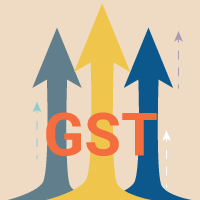Under GST, the return can be filed both online and offline. Under this new tax reform, there is common e-return for Central Goods and Service Tax (CGST), State Goods and Service Tax (SGST), Integrated Goods & service Tax (IGST) and Additional tax. Under GST, a registered taxpayer shall file GST return at GST common Portal either by himself or through his representative.
Every individual registered under GST is required to file a return, despite any sale or purchase activity has been carried out during the return period.
Get the details of GST Refunds in India and its Multiple Facets Get Details
Getting to Understand GST Returns
A return is a statement that a taxpayer is supposed to file as per the law with the tax administrative authorities. Under GST law, a normal individual is required to furnish three monthly returns and one annual return.
Under GST:
- A registered taxable person is required to submit the details of all outwards supplies of goods and services affected during the month by 10th of the subsequent month in GSTR-1.
- GSTR-2 is filed by the registered taxable recipient which includes the details of all input supplies and details about claiming tax credit by 15th of the subsequent month.
- GSTR-3 is filed by a registered taxable person in which the details regarding the monthly return on the basis of finalization of outward and input supplies along with the amount of Tax payable is included.
All the monthly returns must be filed online through a common portal managed by the Goods and Service Tax Network (GSTN). Regular Foreign Non-Residents and casual taxpayers are required to file monthly returns whereas, quarterly tax returns are to be filed by composite taxpayers. The annual return is to be filed by 31st December of the next financial year.
Conditions under which Filing for GST Return are Applicable
- As per GST law, every registered dealer under GST is required to file a return. A return needs to be filed even if there is no business activity during the tax period.
- Government entities or Public-Sector Units (PSU’s) who doesn’t deal in GST supplies or persons exclusively dealing in exempted or non-GST Goods or Services are not required to file a return of GST.
Returns by Composite Taxpayers
Composite Tax is a flat rate of tax which is to be paid based on the turnover of the business in a specific period. It doesn’t take input credits for their purchases. Composite taxpayers are required to file GSTR-4, which is to be filed quarterly.
The Types of Returns that can be Filed under GST

There are various returns which are needed to be furnished under GST Law. GST law states that normal taxpayers must furnish three returns every month and one return must be furnished annually. Taxpayer registered under the composition scheme must file separate returns.
The below table provides the required details for furnishing the returns under the GST law:
| Form Type |
Who needs to file for it |
Due date for filing return Form |
What must be filed? |
| GSTR-1 |
Registered Taxable supplier |
10th of the subsequent month |
Aspects of all outward supplies of goods and services during the month |
| GSTR-2 |
Registered Taxable Recipient |
15th of the subsequent month |
Details of all input supplies of goods and services effected during the month and claiming tax credit |
| GSTR-3 |
Registered Taxable Person |
20th of the subsequent month |
Monthly return on the finalization of the outward and inward supplies along with the amount of tax payable |
| GSTR-4 |
Composition supplier |
18th of the next succeeding quarter |
Quarterly return for compounding Taxpayers |
| GSTR-5 |
Non-Resident taxable person |
20th of the subsequent month |
In this return has to be filed for a Non-Resident Foreign taxable person |
| GSTR-6 |
Input service Distributor |
13th of the subsequent month |
Return has to be filed for input service distributor |
| GSTR-7 |
Tax Deductor |
10th of the subsequent month |
Return to the authorities who deduct tax at source |
| GSTR-8 |
Tax Collector |
10th of the subsequent month |
Details of the amount of tax collected |
| GSTR-9 |
Registered taxable person |
31st December of the next financial year |
Annual Return |
| GSTR-10 |
A taxable person whose registration has been canceled |
Within 3 months of the cancellation date or date of cancellation order, whichever is later |
Final Return |
| GSTR-11 |
An individual having Unique Identification Number (UIN) and claiming a refund |
28 of the month, following the month in which the ITR has been filed |
Details regarding inward supplies need to be furnished by a person having Unique Identification Number (UIN) |
All these returns are needed to be filed online through a common portal which is to be provided by a GSTN.
As per Section 45, every person with GST registration must furnish a final return. In Form GSTR-10, this return is to be furnished electronically via GSTN portal directly or through a facilitation center, notified by the commissioner.
Procedure for Filing GST Returns
- The taxpayer must upload final GSTR-1 return by any of the modes, either directly or through data entry in GST portal by the 10th of the succeeding month.
- The increase or decrease in supply invoices will be calculated as per GSTR-2.
- GST common portal will be automatically generated in GSTR-2. The taxpayer can accept, reject, or modify the provisions in GSTR-2.
- Purchasing taxpayer can submit additional purchase invoice details in the GSTR-2 before it gets uploaded by the supplier, to ensure that the invoice is valid.
- Inward supplies carried out by suppliers during the next 7 days, can be reconciled by the taxpayers with their counterparty taxpayers. This is applicable in the case of any missing supply invoices in GSTR-1 of the supplies.
- By using the GSTN complaint offline facility or by the online common portal, taxpayers can finalize their GSTR-1 and GSTR-2.
- The amount shown in the drafted GSTR-3 return (generated automatically) will be payable by the taxpayer at the online portal, post finalization of activities.
- In GST-3 return, the taxpayer will debit both cash ledger, ITC and mention the debit entry system, which must then be submitted.
A Brief Guideline to Income Tax Return E-filing Get Details
Filing of GST through Tax Return Prepare (TRP) Scheme
- A separate User ID and password is issued to the taxpayers with TRP registration.
- A return will be prepared in the prescribed format as per the information furnished by the taxpayer. With user ID and password, all types of returns can be uploaded on TRP.
- An e-mail or SMS alert containing the date of the returns will be sent automatically to the taxpayer.
- A taxpayer will accept the correctness of the return and will submit it on the link provided in the e-mail or SMS. In case the taxpayer doesn’t respond to the e-mail, it will be considered that return is not submitted.
Submission of any other document will not be required. The data required for accounting shall be provided by the taxpayer to the audit party, deputed by the CBEC, State Tax Authorities and Comptroller and Auditor General (CAG).
Benefits of GST
- Business transactions will become easier.
- Removal of the cascading effect of taxes.
- Filing under GST will be much easier.
- An optional Composition scheme has been started for small businesses.
GST Composition Scheme
GST composition scheme is a choice for informing tax authorities about the business intentions of taxpayers which are available to a registered taxpayer. In case the taxpayer fails to register under this scheme, he/she will be treated as a normal taxpayer and will be administered accordingly. This option is for all businesses i.e. both for goods as well as services. Registered taxpayers whose aggregate turnover is less than Rs. 50 Lakhs in the preceding Financial Year are liable to pay tax at a rate more than 1% (for manufacturers), 2.5% (for restaurant sector) and 0.5% (for suppliers).
Returns Under Composition Scheme
Income Tax Slab for Senior Citizens (Ages between 60 to 80 years)
| Form |
Time |
Due Date |
Includes |
| GSTR-4 |
Quarterly |
18th of the succeeding month |
- Details of outward supplies
- Interstate supplies (Both Interstate and Intrastate) from registered as well as unregistered dealers.
- If any change is to be made in inward supplies as per Form GSTR-4A.
|
| GSTR-4A |
Quarterly |
- |
Details of inward supplies on the basis of GSTR-1 filed by the supplier |
| GSTR-9A |
Annually |
31st December of the next year |
Details of the quarterly returns filed by the suppliers |
 GST Basics
GST Basics
 Classification of GST
Classification of GST
 GST Benefits
GST Benefits








